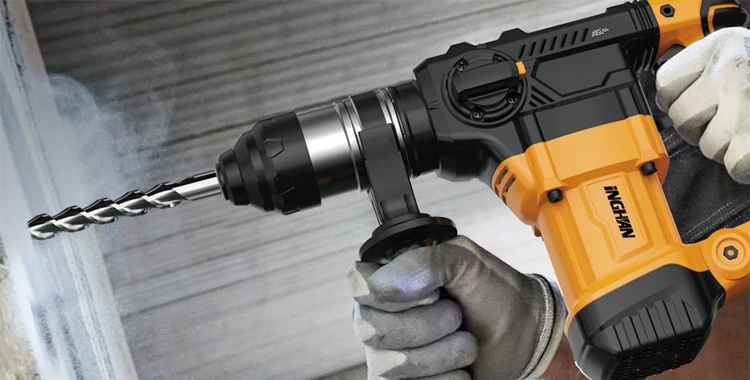Rotary Hammer Instructions
(I) Preparation before operation
Check the integrity of the tool: Before using the rotary hammer, carefully check whether the tool has any damage on the outside, such as cracked casing, broken wires, etc. Make sure that all parts are firmly connected and there is no sign of looseness. At the same time, check whether the drill bit is installed correctly and is not excessively worn.
Choose the right drill bit: Choose the appropriate drill bit according to the specific work requirements. Drill bits of different materials and specifications are suitable for different work scenarios. For example, when drilling holes in concrete, you need to use a carbide drill bit; if the hole diameter is large, you need to choose a drill bit of the corresponding size. Note that the diameter and length of the drill bit must match the performance parameters of the rotary hammer.
Wear protective equipment: To ensure safe operation, personal protective equipment must be worn. This includes safety goggles to prevent debris from splashing into the eyes; earplugs or earmuffs to reduce noise damage to hearing; gloves to provide better grip and protect the hands from injury; dust masks to avoid inhaling dust generated during drilling.
(II) Operation steps
Adjust the working mode: Rotary hammers usually have multiple working modes, such as hammer drill mode (rotation and hammering), pure drilling mode (rotation only) and chiseling mode (hammering only). Select the appropriate mode according to the work task. For example, when drilling holes in concrete, select hammer drill mode; if you only need to drill holes in wood or metal, select pure drilling mode; when performing light demolition or chiseling work, use chiseling mode. Switch the mode by operating the mode selection switch, and make sure the switch is in place and locked.
Start the tool: Plug the rotary hammer into a qualified power outlet (for electric corded models), or make sure the battery is fully charged and properly installed on the tool (for electric cordless models). Hold the tool firmly, place your finger on the switch, and press the switch to start the rotary hammer. When starting, the tool may vibrate slightly, which is normal.
Start working: Aim the drill bit at the work surface, keep the tool perpendicular to the work plane, and slowly apply pressure to allow the rotary hammer to start working smoothly. During the drilling process, do not press the tool too hard, and let the hammering and rotating force of the tool act naturally on the material. If you feel that the tool encounters great resistance or jams, you should stop the operation immediately and check whether the drill bit is stuck or whether there are foreign objects in the working material. When chiseling, keep the tool vertical and move the tool slowly along the part to be chiseled, using the hammering force to remove the material.
Control drilling depth (optional): Some rotary hammers are equipped with a drilling depth control device. If you need to accurately control the drilling depth, you can adjust the depth control lever or set the corresponding depth stopper according to actual needs. During the drilling process, when the drill bit reaches the set depth, the depth control device will prevent the drill bit from going deeper to ensure that the drilling depth meets the requirements.
(III) Post-operation maintenance
Cleaning the tool: After use, turn off the rotary hammer and unplug the power plug (or remove the battery). Wipe the surface of the tool with a clean cloth to remove attached dust and debris. For the drill bit, use a brush to clean the residual material on the drill bit to keep the drill bit sharp. If the tool comes into contact with water or other corrosive substances during use, it should be rinsed with clean water in time and wiped dry to prevent the tool from rusting.
Check the wear of the tool: Regularly check the various parts of the rotary hammer, especially the drill bit, transmission parts and impact mechanism. Check whether the drill bit is worn, broken or deformed. If the drill bit is severely worn, it should be replaced with a new drill bit in time to ensure work efficiency and drilling quality. Check whether the connection parts of the transmission parts and impact mechanism are loose. If they are loose, they should be tightened in time. At the same time, observe the wear of these parts. If there is obvious wear, repair or replacement should be considered.
Store the tool properly: Store the cleaned and inspected rotary hammer in a dry, well-ventilated place that is out of reach of children. If the tool is not used for a long time, it is recommended to perform simple maintenance and test run of the tool every once in a while to ensure that the tool is in good standby condition. For electric wired rotary hammers, the wires should be arranged to avoid entanglement or damage; for electric wireless rotary hammers, the battery should be charged to a certain power before storage, and the battery should be charged and discharged regularly to extend the battery life.






























